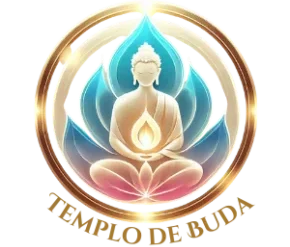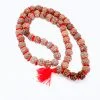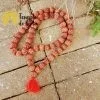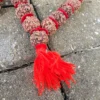Description
Japa Rudraksha Case with 5 Beads Muhkhis with 54 Beads Red Sweeper
( do count 2 times – 108)
Of length 50 cm, where each seed has approximately 2cm each.
The seeds of Rudraksha (literally “God’s eyes”) come from the sacred tree of the same name, which only grows in the Himalayas. They are known to provide peace of mind. They also protect against negative energies and favor spiritual practice.
You can read more about this wonderful seed here
About the 5 mukhis, called panchamukhi, which is ideal for everyone.
It represents the form of Shiva and is associated with the five elements: Earth, Water, Fire, Air and Ether. The Rudraksha of 5 mukhis controls the five elements in the body of the wearer, assisting in all diseases related to these elements.
This type of seed is considered highly auspicious and even compared to a saint (Sadhu).
About Japa Malas
A Japa Mala, or simply suitcase (Sanskrit: ,いいい; mālā), refers to a series of accounts, popular in India and Buddhist countries, that are used to keep count while reciting, singing or mentally repeating mantras or the name(s) of a particular deity. In both India and Asia, the recitation of mantras is a very popular practice. As sacred utterances, mantras can be silently repeated or sung for different reasons and purposes. Used predominantly by Hindus, Buddhists and Sikhs as auxiliaries of meditation and devotion, mantras are sound vibrations that instill concentration in the devotee and facilitate spiritual growth.
Japa Mala’s devotional practice resembles the Catholic use of the rosary – the Rosary. Both strings of beads help their respective religious believers record the number of times the prayer/mantra has been said.
The Sanskrit word japa is derived from the root Jap, which means “to pronounce in a low voice, to repeat internally, to murmur”.
A wide variety of materials is used to make suitcase accounts. In Hinduism, the Vaishnavas usually use Tulsi’s Japamala beads. The Shaivitas use Rudraksha’s accounts. Aghori practitioners usually use human skull fragments for their bags.
Some Tibetan Buddhist traditions call for the use of bone (animal, more common yak) or sometimes human, with past Lamas bones being the most valuable. Others use wood or seeds from the Bodhi tree or seeds from the Lotus plant. Semi-precious stones, such as kornaline and amethyst, can also be used. The most common and least expensive material is sandalwood. In Hindu Tantra, as well as in Buddhist Tantra or Vajrayana, the materials and colors of beads can relate to a specific practice.
Handmade in India.
100% original and natural Rudraksha .
You can view the product in detail on our YouTube channel.
There are several pieces and they all vary in color, size, and texture because they are natural seed crystals and unique in essence.
If you have any questions regarding this product on the Templo de Budayou can contact us by Whatsapp, email or Facebook










 Adquira este produto e obtenha
Adquira este produto e obtenha 



Reviews
There are no reviews yet.